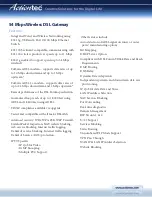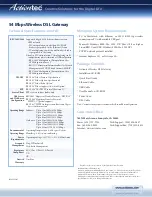
Creative Solutions for the Digital Life
™
54 Mbps Wireless DSL Gateway
Technical Specifications
ICMP
UDP
TCP
IP Router
RIP
DHCP Server
DHCP Client
NAT, PAT
(IP Masquerading)
NAT ALGs
(Application
Level Gateway)
(NAT Pass Through)
NAT advanced
features
Firewall
Universal
Plug-N-Play
(UPnP)
PPPoA
PPPoE
RFC 792 “Internet Control Message Protocol”
RFC 768 “User Datagram Protocol”
RFC 793 “Transmission Control Protocol”
Support Static Route
Support Unnumbered Mode
RFC 1058 “Routing Information Protocol”
RFC 1723 “RIP Version 2 - Carrying Additional
Information”
RFC 2453 “RIP Version 2”
RFC 1812 “Requirements for IP Version 4 Routers”
RFC 1191 “Path MTU Discovery”
RFC 2131 “Dynamic Host Configuration Protocol”
RFC 2132 “DHCP Options and BOOTP Vendor
Extensions”
RFC 2131 “Dynamic Host Configuration Protocol”
RFC 2132 “DHCP Options and BOOTP Vendor
Extensions”
The DHCP client supports the following minimal
subset of options described in RFC 2132:
• Requested IP Address (requested by default; is
mandatory)
• Parameter Request list (subnet-mask only)
• IP Address Lease time (dhcp-lease-time)
• Client-identifier (dhcp-client-identifier)
• Default route (routers)
• DNS proxy servers
RFC 2663 “IP Network Address Translator (NAT)
Terminology and Considerations”
RFC 3022 “Traditional IP Network Address
Translator (Traditional NAT)”
Support for many well known applications
Port Forwarding
DMZ
Service Blocking
Web site blocking
Web Activity Log
Stateful Firewall: multiple security levels
Basic IDS: Stateful Packet Inspection for prevention
of Denial of Service (DoS) attacks
Internet Gateway Device (IGD) Standardized Device
Control Protocol V 1.0
RFC 2364 “PPP Over AAL5”
RFC 2516 “Method for Transmitting PPP Over
Ethernet (PPPoE)”
Features
ADSL
ATM
OAM
Wireless
Ethernet
Bridge
IP
ARP
Descriptions
ITU G.992.1 (G.dmt), G.992.2 (G.Lite), G.994.1
(G.hs), G.992.3/4 (ADSL2), G.992.5 (ADSL2+)
ANSI T1.413 Issue2
ATM User-Network Interface, Version 3.1, Section 3.
The ATM Forum
• The full VPI range (0 – 4095) and VCI range
(1 – 65535) are supported
• Adaptation Layers AAL5, AAL2 and AAL0 are
supported
• The traffic shaping function supports traffic
classes CBR, VBR (real time and non-real time)
and UBR (with PCR limiting)
ITU-T Recommendation I.610 B-ISDN “Operation
and Maintenance Principles and Operations
• F5 segment and end-to-end loopback cells
IEEE 802.11g
IEEE 802.11b
IEEE 802.1x
WPA
WEP 64/128/256 bit encryption
SSID Broadcast enable/disable
ISO/IEC 8802-3; ANSI/IEEE standard 802.3 part 3
• IEEE 802.3x – Full Duplex capable
• IEEE 802.3u – Auto negotiation
RFC 1213 "Management Information Base for Network
Management of TCP/IP-based Internet: MIB-II"
D-I-X "The Ethernet - A Local Area Network: Data
Link Layer and Physical Layer Specifications"
Transparent MAC level bridge for Ethernet-like devices
in conformance with the IEEE 802.1d specification
ISO/IEC 10038:1993 (E), Std 802.1D
RFC 1213 "Management Information Base for Network
Management of TCP/IP-based Internet: MIB-II"
RFC 1493 “Definitions of Managed Objects for Bridges”
RFC 791 “Internet Protocol”
RFC 950 “Internet Standard Subnetting Procedure”
RFC 1122 “Requirements for Internet Hosts –
Communication Layers”
RFC 1191 “Path MTU discovery”
RFC 1213 “Management Information Base for Network
Management of TCP/IP-based Internet: MIB-II”
RFC 894 “Standard for the Transmission of IP
Datagrams Over Ethernet Networks”
RFC 826 “Ethernet Address Resolution Protocol: Or
Converting Network Protocol Addresses to 48-bit
Ethernet Address for Transmission on Ethernet
Hardware”






















